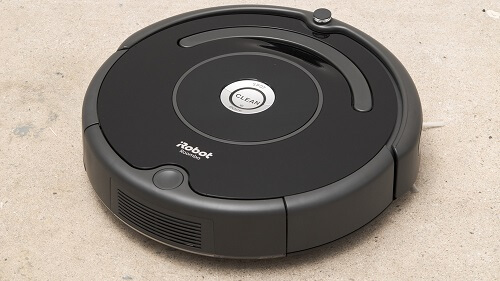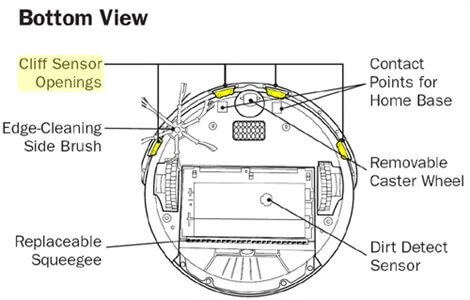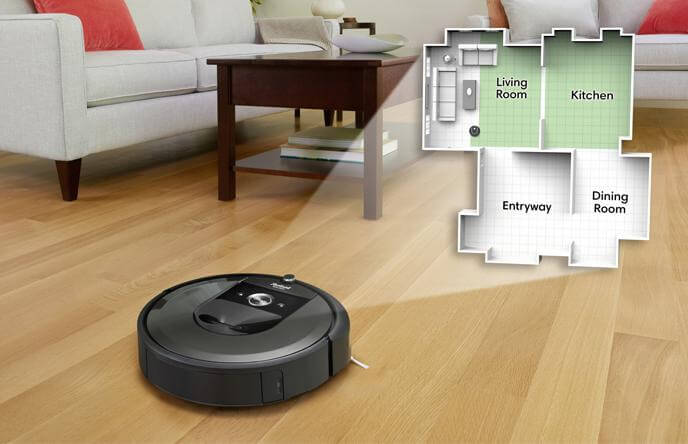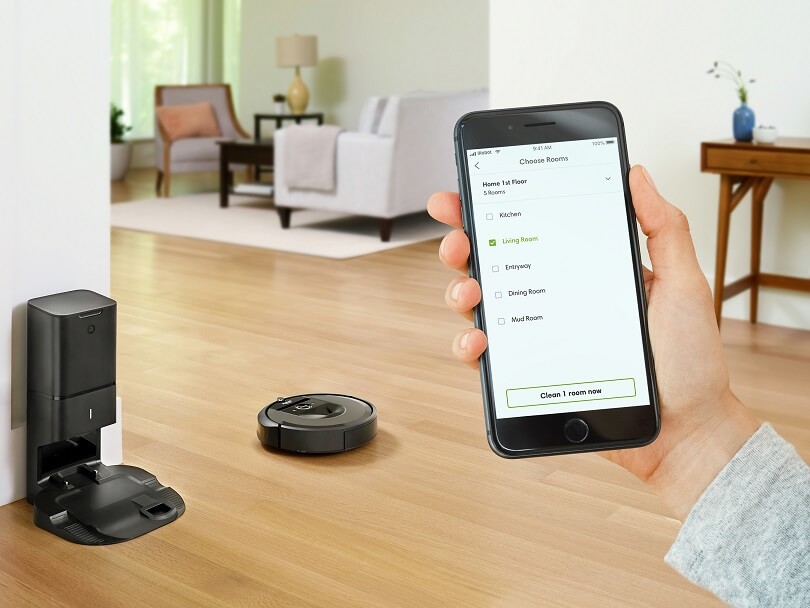
How Does a Roomba Work? Explained With Pictures
Cleaners Talk is reader-supported. This post contains affiliate links, we may earn a commission at no additional costs to you. As an Amazon Associate we earn from qualifying purchases.
The idea of a robot vacuum is enticing to anyone who groans at their growing list of household chores.
But before you invest your hard-earned money into this seemingly magic machine, you might be wondering—how does a Roomba work? Will it be smart enough to recognize your chihuahua's paw from a clump of dirt?
A Roomba uses infrared sensors and photocell sensors to navigate by bouncing light off an object to detect its presence, while its piezoelectric sensor acts as a dirt detector. When dirt hits the sensor, the Roomba receives tiny electric impulses, which will prompt the Roomba to work and pick up the dirt.
If you want to learn more about how a Roomba works in greater detail, including its most important features, read below. We'll help you understand the mechanics of a Roomba without an engineering degree.
How Do Roombas Work and Clean Autonomously
There are four main parts to a Roomba: sensors, bump, wheels, and brushes. These parts work together to navigate the Roomba and clean your home. In a nutshell, here’s how a Roomba works:
- A Roomba uses infrared and photocell sensors to navigate around a room. These sensors each serve a different purpose. For example, cliff sensors help the Roomba detect stairs or cliffs so it does not fall down. Similarly, wall sensors let the Roomba know that a wall is nearby.
- A Roomba only needs one bump to stop. If the Roomba bumps into something, the force of impact causes the sensor to trigger, sending the robot in a different direction. This impact has to be from an immovable object, such as a table leg or a wall.
- The wheels of a Roomba contain optical encoders. By using a light sensor, a Roomba is able to determine how far it has traveled. Newer Roomba models allow you to see the data via the smartphone app.
- A Roomba uses two multi-surface brushes. The smaller brush, also known as the side brush, gathers dust and puts it onto the Roomba’s path. The brush roller, also known as the beater bar, accelerates it into the vacuum’s suction channel.
That is how a Roomba works. However, if you want to learn more about each aspect, continue reading below.
1. The Power of Sensors

Sensors on the Roomba are what keep it from trying to clean your pup and running at high speed into the table where your grandmother's antique sits.
It does so by using infrared beams and a photocell sensor at the front of the machine. These help the Roomba slow down when they sense an object is near. Beneath them, a touch sensor makes the Roomba stop once it bumps into an object.
Also, you might be wondering—do Roombas fall down stairs?
No, you don't. That's thanks to its infrared sensors that point straight to the ground from beneath the machine. As a result, it senses steep drop-offs before it's too late.
The other advantage of these sensors is they'll detect oncoming cords or other items that the Roomba could get tangled in.
Sensors for Dirt
Knowing how to avoid objects isn't enough for an effective Roomba—it also needs to know when it encounters an extra dirty spot.
By using piezoelectric sensors, the Roomba knows when it's in a dirty area; it can sense debris flying up and touching it. Then, when those dirt particles hit the machine, it knows to reverse so that it can go over the area again, this time at a slower speed.
The Roomba will continue cleaning the area, monitoring the dirt supply via how many electric impulses the piezoelectric sensor produces. The more impulses it has, the more dirt is present.
2. Weighing Roomba Models
As is the case for most successful pieces of technology, there are several generations of Roombas with improved functionalities in the newer models.
so, before you buy a Roomba, make sure you know how your model works and what it can—and can't—do.
There are too many variations to do these models justice here. So, read their labels to get a feel for what to expect. But to give you a base, below are some notable differences:
3. Understanding Roomba's Cleaning Patterns
There's a good reason if you're watching your new Roomba and scratching your head about the route it's taking—older models of Roombas operate on a random bounce basis.
In other words, when a Roomba hits an object, it will move away from it in a random direction to continue their cleaning. This is why most people consider this method a random bounce.
In contrast, wall following is another typical Roomba pattern in older models. When your Roomba uses wall following, it'll move around the perimeter of a room, using its brushes to whisk debris from corners.
Should you wish to level up your Roomba's effectiveness, you can purchase a model that's compatible with virtual wall barriers. These help a Roomba to better understand the limits of where different rooms in your home start and end.
That said, you can take your cleaning another step up by purchasing a Roomba that has mapping capabilities.
Wheels and Brushes
If you think there can't be anything special about Roomba wheels, think again. The Roomba uses optical encoders to determine its travel distance using a light sensor.

Furthermore, designers engineered the Roomba with two brushes. The first brush that passes over your floor helps loosen up dirt and debris. The second brush then sweeps through, whisking away all that grime into the Roomba's vacuum suction.
However, after several cleaning sessions, you need to clean the brushes. By removing the built-up hair and debris, your Roomba would be able to pick up dirt for a long time.
4. Getting a Cleaner House with Mapping
When you're considering the question, "How does a Roomba work?" you now know that the model matters.
Older Roomba models use a random navigation technique. They do so by meandering around your house, cleaning it without rhyme or reason. As a result, missed spots are relatively common.
Nowadays, Roomba's newer models offer intelligent mapping options called Vision Simultaneous Localization and Mapping (VSLAM). As your Roomba makes its way around a room, it maps its whereabouts.
That way, it knows where it's cleaned and the areas of your home that still need attention.
According to a Roomba-led study, they found cleaning time dropped by 20% due to VSLAM. Furthermore, it showed that houses using VSLAM technology had cleaner floors than non-mapping Roombas.
Here's an even bigger plus for people wanting 24/7 squeaky clean floors: The i7+ and s9+ Roomba models remember their mapping from the previous clean. Therefore, they can be more efficient at cleaning your rooms in the future.
5. How the Roomba Knows What It's Doing

You don't need a Wi-Fi connection to run a Roomba, but it's helpful.
All Roomba models offer Wi-Fi connectivity features that allow you to control your cleaner from an app. That means if you're at the airport for a business trip and forgot that you wanted to shut off your Roomba before you left, you can do so from your phone.
Furthermore, newer Roomba models allow you to use the app and a Wi-Fi connection to set up a cleaning schedule or review reports from past cleanings.
Should you be unable to run a Roomba on Wi-Fi, you can control the machine manually by pressing the "clean" button.
FAQ on How a Roomba Works

1. How does a Roomba know when to stop?
A Roomba knows when to stop thanks to its combination of infrared and photocell sensors. The cliff sensors tell the Roomba to stop when it detects stairs or a cliff, while the wall sensors tell the Roomba to stop when a wall is nearby.
2. How does a Roomba clean corners?
A Roomba cleans corners by using its side brush, which is located on the front left side of a Roomba. The little side brush gathers dust and dirt from corners into the Roomba’s path, which will then be picked up by the main brush roller.
However, there are D-shaped Roombas, like the Roomba S9, that clean corners better than round Roombas do. Thanks to its PerfectEdge Technology with advanced sensors and a specially designed Corner Brush, it optimizes cleaning deep into corners and along edges.
- CLEANS UP AFTER YOU AND ITSELF: With groundbreaking technology and a sophisticated design, the s9 plus is one of the smartest, most powerful robot vacuum...
- DETAILED POWERFUL CLEAN: PerfectEdge Technology with advanced sensors and a specially designed Corner Brush, this vacuum offers optimized cleaning deep...
- VACUUMS MESSES IN THE MOMENT: Cleaning crumbs is now as easy as “Roomba, clean under the kitchen table.” A simple request to your voice assistant or...
Are You Ready for a Roomba?
For such a small machine, there's a lot of engineering that goes into the Roomba. Nevertheless, the next time someone comes to your house and asks you, "How does a Roomba work?" you should be able to give them an in-depth answer.
Given that 60% of people complain about their vacuum, don't be surprised if they envy your hands-off cleaning, making a bee-line to the store to buy a Roomba.



